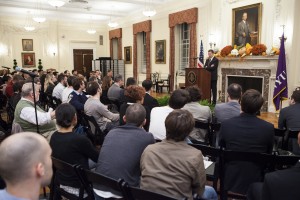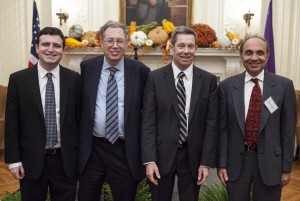Friedrich A. von Hayek may be known primarily as a classical liberal economist and political philosopher, but he was also a constitutional theorist, as Judge Jeffrey Sutton of the U.S. Court of Appeals for the Sixth Circuit explained when he delivered the ninth annual Friedrich A. von Hayek Lecture on October 17. The event, co-sponsored by the Classical Liberal Institute and the NYU Journal of Law & Liberty, was introduced by Richard Epstein, Laurence A. Tisch Professor of Law and director of the Law School’s new Classical Liberal Institute.
In his lecture, “Courts, Rights, and New Technology: Judging in an Ever-Changing World,” Sutton recounted that Hayek, despite his support among libertarians, actually admired federalism. Hayek favored the use of judicial review and a judicially enforceable Bill of Rights to restrain legislatures, including the courts’ safeguarding of unenumerated rights under the Ninth Amendment.
“There’s one context in which Hayek probably thought that robust judicial involvement is an especially good idea: the context of new technology,” said Sutton. “No enumeration of rights can fully anticipate the science of the future. New technology provides new domains for good or ill.”
 Although many judges are not terribly tech-savvy, Sutton said, they nevertheless are called upon to render decisions in highly technical cases. He pointed to a number of indications of Supreme Court justices’ discomfort with adjudicating such cases, including Chief Justice William Rehnquist’s separate opinion in Daubert v. Merrell Dow Pharmaceuticals. That case gave rise to the Daubert standard, which established trial judges as the gatekeepers who determine whether scientific expert testimony is valid according to the scientific method. Nevertheless, at the time the case was decided, Rehnquist wrote, “I defer to no one in my confidence in federal judges; but I am at a loss to know what is meant when it is said that the scientific status of a theory depends on its ‘falsifiability,’ and I suspect some of them will be, too.”
Although many judges are not terribly tech-savvy, Sutton said, they nevertheless are called upon to render decisions in highly technical cases. He pointed to a number of indications of Supreme Court justices’ discomfort with adjudicating such cases, including Chief Justice William Rehnquist’s separate opinion in Daubert v. Merrell Dow Pharmaceuticals. That case gave rise to the Daubert standard, which established trial judges as the gatekeepers who determine whether scientific expert testimony is valid according to the scientific method. Nevertheless, at the time the case was decided, Rehnquist wrote, “I defer to no one in my confidence in federal judges; but I am at a loss to know what is meant when it is said that the scientific status of a theory depends on its ‘falsifiability,’ and I suspect some of them will be, too.”
The challenges, Sutton said, go beyond merely understanding new technology, extending also to how old laws should be applied in those innovative realms. “An originalist cannot decide a case by asking what Madison or Hamilton thought about telephones or the radio, let alone DNA, the Internet, or video games,” he said.
In some Supreme Court opinions, justices have indicated that the constitutional status of a law may be transitory as technology progresses.Ashcroft v. Free Speech Coalition overturned a part of the Child Pornography Prevention Act of 1996 that outlawed virtually created pornography involving what appear to be minors. In his concurrence, Justice Clarence Thomas hypothesized that “technology may evolve to the point where it becomes impossible to enforce actual child pornography laws because the Government cannot prove that certain pornographic images are of real children. In the event this occurs, the Government should not be foreclosed from enacting a regulation of virtual child pornography.”
Sutton also pointed out that many highly technical cases create strange judicial bedfellows. The pattern: Chief Justice John Roberts, Justice Anthony Kennedy, Justice Stephen Breyer, and Justice Samuel Alito often take a pragmatic view in siding with government, while Justice Antonin Scalia, Justice Ruth Bader Ginsburg, Justice Sonia Sotomayor, and Justice Elena Kagan typically take a more skeptical approach to government power.
This division, Sutton revealed, leaves a surprising tie-breaker. “In how many areas of the law can you say that Justice Thomas is the swing justice?” he said, adding, “Conventional legal sources, like history and precedent, do not answer many of the novel questions posed at the forefront of technological change. When it comes to the border between law and technology, every justice becomes a common-law judge, and every dispute becomes a case of first impression.”

Journal of Law and Liberty Editor-in-Chief Adam Shamah, Professor Richard Epstein, Judge Jeffrey Sutton, and Professor Mario Rizzo
Timing is crucial when courts take up technological issues, Sutton argued. The Court has not yet made a Fourth Amendment ruling regarding the search of cell phones found on or near arrestees. Had it done so 20 years ago, he suggested, the justices might have decided such searches were permissible because phones contained scant private data.
“Today’s phones contain a lot of private information: text messages, notes, apps, browsing histories, and much else,” he said. “An opinion saying that people have a diminished expectation of privacy in their cell phones would seem nearly as strange as an opinion saying that movies aren’t speech.” (The Court said just that—prematurely, it would seem—in 1915.)
The courts must engage in a balancing act, Sutton suggested. “The trick is finding the sweet spot,” he said. “The justices must figure out exactly when technology has stabilized, and only then step in. But it’s hard enough for judges to figure out how today’s technology works. Expecting them also to figure out how much that technology is likely to evolve during the next decade…is asking a lot of non-specialists.”
Legislatures, he said, can help take the lead. Unlike courts, they can hold hearings, call on experts and specialist staffers, operate outside the boundaries of originalist interpretation, and employ flexible and multiple approaches to achieving solutions: “Why would we want pragmatic judgments to be made by unelected, inexpert, life-tenure judges rather than elected, regularly accountable legislators?” Sutton was not suggesting that legislatures should have unilateral sway over new technology and its repercussions, but did assert that it was time for the legislative and judicial branches work more in tandem. “I think the adversarial process still works,” he said. “I do think, however, they are going to be humble about it and likely to move very slowly. The fact is technology may become obsolete, but the Bill of Rights is not going to become obsolete.”
Couresty of NYU Law website.

